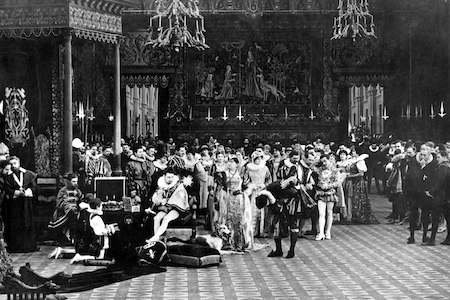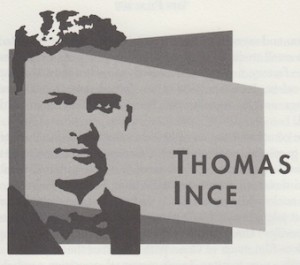Born: November 6, 1882, Newport, RI
Died: November 19, 1924, Hollywood, CA
Being able to give orders without giving offense made Ince’s method work.
—Thomas Bohn
As well as being one of the towering figures in Hollywood’s early days, Thomas Harper Ince originated the film industry’s most basic movie production techniques; he fathered the concepts of budgets, shooting scripts, multiple camera units and set crews made up of specialists. Through his iron grasp on hundreds of films, he became the early model of a Hollywood producer, and his groundbreaking production innovations have remained relatively unchanged for eighty years.
Ince’s entrance into and exit from moviemaking are two of Hollywood’s most bizarre stories. In 1910, he was a struggling performer whose last performance was in one of D.W. Griffith’s first Biograph films. Frustrated with screen acting, he decided to produce movies independently, and he quickly displayed an aptitude for pulling a team of filmmakers together. His new enterprise got the attention of the Edison Trust, which was systematically putting independents out of business; just two months after his precarious start as a producer, he was off to Cuba to escape their brutal tactics. Along with him went fellow Biograph star Mary Pickford; after directing her in a comedy short, he was more than ever determined to make a living in the volatile film industry.
When it was necessary to return to moviemaking in the States, Ince traveled to Texas and eventually settled in California, where, like Mack Sennett, he set up a small studio to meet demand for shorts. By 1912, Ince had himself a movie factory, turning out hundreds of reels a year. The popular western one-reelers Ince specialized in forced him to construct bigger surroundings and his new location became the first major studio built in Hollywood.
The Ince compound was an eighteen-thousand-acre facility outside Culver City. Built to resemble Mount Vernon, George Washington’s plantation-style home, it was the predecessor of the modern studio, with individual offices for writers and directors, sound stages, dressing rooms, a cafeteria and warehouses, all enclosed by a giant fence that spurred the playful Mary Pickford to refer to it jokingly as a “lot.” Others mocked its enormous stretch by dubbing it “Inceville.” The antebellum feel of the buildings later prompted David O. Selznick to film much of Gone with the Wind (1939) there.
Along with a new location, Ince’s mammoth operation needed a new discipline. Traditionally, the budgets on early silent films were so low that many studios didn’t bother to clearly define all of their costs. But Ince insisted that every penny be meticulously documented. Accountants were hired to keep a close eye on efficiency and ensure strict compliance with budgets. To avoid duplication of effort, Ince divided film production crews into several shooting units that each worked on a variety of projects. Every day, he assigned one time to travel to the nearby mountains and handle the location shots for several westerns while other teams were on the lot shooting barroom or bunkhouse interiors; actors and directors moved in and out according to the dictates of his detailed schedules. Instituting these streamlined processes, Ince was following the trend that was taking hold in industries all over America: he was applying Henry Ford’s principles of assembly-line automaking to films. In his quest for strict accountability, the artistry of his films became secondary to sheer business sense.
The most useful contribution of Thomas Ince, however, was the detailed continuity script. A rigid guideline for filming, it broke down every detail of a movie by numbering scenes, suggesting camera setups, outlining costume and prop needs, recommending camera angles and lighting and hinting at postproduction details such as special effects and titles in scribbled notes throughout the margins. The Ince script became gospel, and he exerted his creative and financial control through it. He often used a detailed script as a way of changing a scene without having to confront a volatile director: in a note delivered by messenger, he would order the director to hold all shooting on a certain sequence in the script until costs could be evaluated and approved, then secretly order a second-unit team to shoot the scene exactly as written in the detailed script, and finally tell the director that the scene had already been shot.
As a “director-general,” Ince could review many projects simultaneously, writing scenes and making comments. He watched daily rushes and groomed actors for stardom. A capable storyteller and technician, Ince was more responsible for his studio’s final output than the film’s director, and he often took credit with “Thomas H. Ince Presents” above the title. His centralized management techniques were so successful that other studios adopted his methods immediately, particularly his incessant note-writing. David O. Selznick would become an infamous memo-write, and the young Irving Thalberg developed Ince’s penchant for shooting schedules and budget worksheets.
One consequence of Ince’s methodology was the introduction of labor unions. Most producers in those days allowed a person to contribute to a film as an actor, writer, director or crew member, often doing several jobs on the same production. Ince would no longer provide those opportunities. His highly structured system clustered craftspeople by specialty, creating a division of labor. Soon, trade organizations were formed to represent the interests of each group. By the early 1920s, the film industry was heading smack into the era of the studio system.
Thomas Ince was regarded among his contemporaries as a true visionary. At times, he partnered with such luminaries as Mack Sennett, Allan Dwan and D.W. Griffith. One such collaboration took place in 1915, when Ince formed the Triangle Film Corporation in concert with Sennett and Griffith. They produced a string of famous and commercially successful westerns starring William S. Hart. However, Ince could not get the difficult Griffith to adhere to his rigid schedues, and the troubled studio faltered after Intolerance (1916) failed to recover costs.
In his later years, Ince dissolved his interests in motion picture studios and looked for work as a hired gun on big productions. He was sought by Paramount and MGM for his efficiency and became a forerunner to such modern independent producers as David O. Selznick, Darryl Zanuck and Alexander Korda. Throughout his life, he remained one of the most prominent and influential producers in Hollywood.
The death of Thomas Ince was shrouded in mystery and confusion. Although only forty-four years of age, Ince was already a puffy-looking man of frail health. Ulcers and liver problems had plagued him for years. One night, he boarded publishing magnate William Randolph Hearst’s yacht for a seafaring celebration of his appointment to head Hearst’s new production company. When the boat returned to shore, a seriously ill Ince was hurried to a train in Del Mar en route to a family doctor. His condition was critical enough that his body had to be placed on a stretcher and passed through the window of the train. When he arrived at home, a family physician cared for him for two days before a heart attack supposedly caused his death. A coroner’s certificate that listed the reason for his death as “natural causes” started rumors about the true nature of the events on the yacht. Gossip columnist Louella Parsons seized a chance to fuel speculation by alluding to “Hollywood’s darkest scandal” in a fabricated story that had Ince fatally shot aboard the yacht by the jealous newspaper tycoon. In a persistent and confounded piece of movie lore, Ince was allegedly mistaken for Charlie Chaplin, whom Hearst believed to be involved with his mistress. Hearst is said to have put a bullet into Ince’s abdomen in the heat of passion, causing him to slowly bleed to death. In the absence of any supporting facts, the scandal is rumored to have been completely covered up by Hearst. The story is vehemently denied by Ince’s family, who insist that his stomach problems were preexisting and that his death was not at all dramatic or mysterious. Still, that depiction continues to taint the memory of Ince as one of the true pioneers of motion picture production.
To read all the republished articles from ‘The Film 100,’ go to Reintroducing the Film 100 here on Keyframe.





